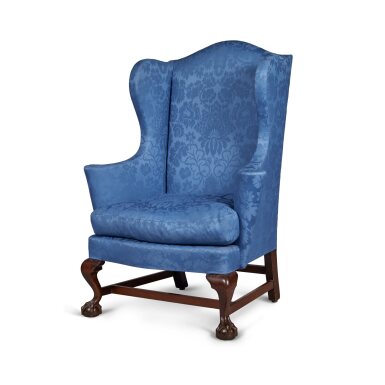Property from the Collection of Dr. Larry McCallister
Property from the Collection of Dr. Larry McCallister

A Very Fine and Rare Chippendale Mahogany and Poplar Easy Chair, Hartford County, Connecticut, Circa 1780
Auction Closed
September 22, 07:47 PM GMT
Estimate
5,000 - 8,000 USD
Lot Details
Description
A Very Fine and Rare Chippendale Mahogany and Poplar Easy Chair
Hartford County, Connecticut
Circa 1780
Height 47 1/4 in. by Width 37 1/4 in. by Depth 25 in.
Sotheby’s, New York, Fine Americana, June 27, 1991, sale 6201, lot 360;
Thomas P. and Alice K. Kugelman, Hartford, Connecticut;
Sotheby’s, New York, Important Americana: Furniture, Folk Art, Silver, Porcelain, Prints and Carpets Including Property sold by The Philadelphia Museum Of Art, January 25, 2013, sale 8950, lot 326.
Maine Antiques Digest, August 1991.
Of exceptional quality and proportion, this elegant easy chair follows the classic design of the form made in New England, characterized by an arched crest, ogival wings, outscrolled arms with conical supports, a rounded seat, and cabriole legs with claw and ball feet joined by stretchers.
The distinctive cabriole legs with uncarved knees, finely articulated claw and ball feet and stretchers suggest the Hartford, Connecticut area as the place of origin. Eliphalet Chapin (1741-1807) of East Windsor made sets of chairs with very similar claw feet for Ebenezer Grant (1706-1797) in 1775 and for Alexander King (1749-1831) in 1781 (see Kugelman, Thomas P. and Alice K. Kugelman with Robert Lionetti. Connecticut Valley Furniture: Eliphalet Chapin and His Contemporaries, 1750-1800, Hartford, 2005, fig. 3.2 and 3.3, p. 135 and cat. 57d, p. 146.) Remarkably consistent and meticulous in his workmanship, Chapin executed virtually identical claw feet for the Grant and King sets with slightly flattened balls with short wedge-shaped talons. His claw feet are reminiscent of the type made in Philadelphia, where Chapin worked as a journeyman. The use of stretchers in combination with claw and ball feet is atypical for the Chapin shop and suggests the chair may be the work of a former apprentice.
In July of 1991, wood samples were taken from this chair and micro-analyzed at the University of Massachusetts at Amherst. The micro-analysis identified that the right rear stile is made of yellow polar; the innermost piece of the left cone is made of cherry; the mid-piece of the left cone is made of yellow poplar; the rear seat rail is made of yellow poplar; and the applied serpentine piece of the front rail is made of Eastern white pine. A visual inspection indicates the frame is made of yellow poplar with the exception of the specified pieces mentioned above, the two pine spacers attached to the stile and wing assembly, and the innermost vertical piece on the right cone is made of cherry. The front legs and stretchers are mahogany.
